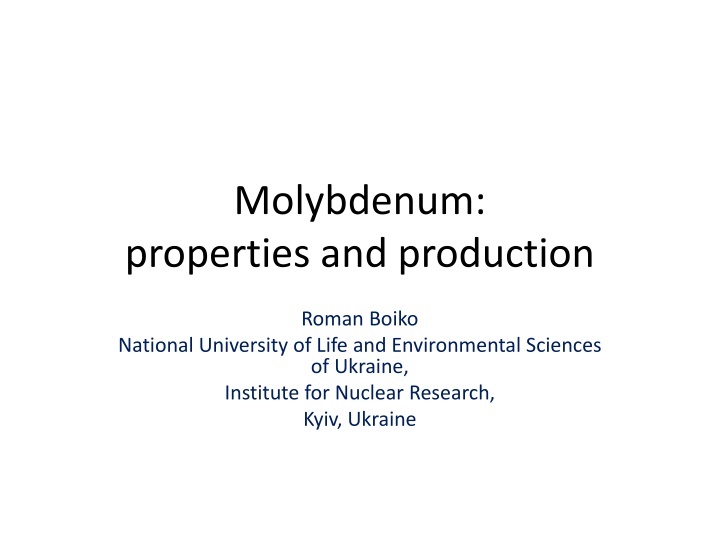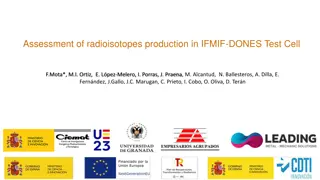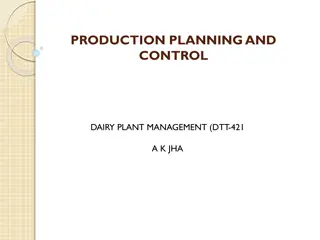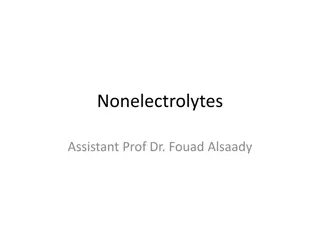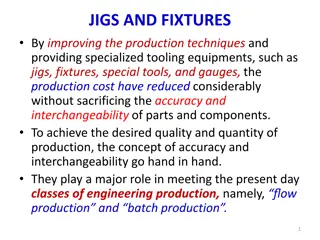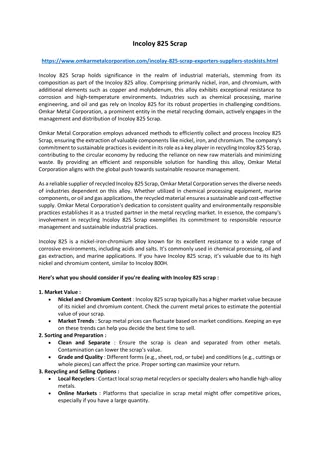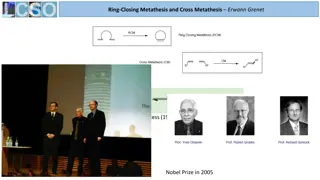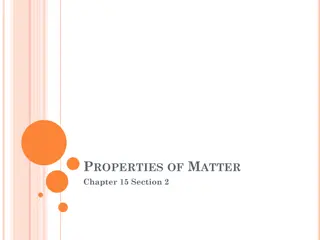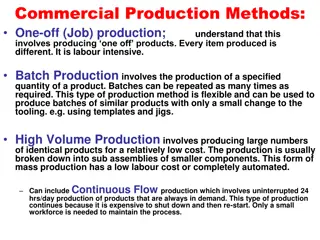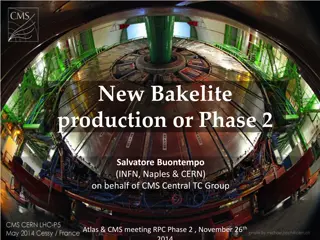Molybdenum: Properties and Production Overview
Molybdenum is a metal with atomic number 42, known for its high melting point and diverse applications in stainless steel, alloy steels, and superalloys. This overview covers its chemical properties, production methods, and uses in various industries.
Download Presentation

Please find below an Image/Link to download the presentation.
The content on the website is provided AS IS for your information and personal use only. It may not be sold, licensed, or shared on other websites without obtaining consent from the author.If you encounter any issues during the download, it is possible that the publisher has removed the file from their server.
You are allowed to download the files provided on this website for personal or commercial use, subject to the condition that they are used lawfully. All files are the property of their respective owners.
The content on the website is provided AS IS for your information and personal use only. It may not be sold, licensed, or shared on other websites without obtaining consent from the author.
E N D
Presentation Transcript
Molybdenum: properties and production Roman Boiko National University of Life and Environmental Sciences of Ukraine, Institute for Nuclear Research, Kyiv, Ukraine
outline What is molybdenum? Chemical properties of molybdenum and its compounds Molybdenum production Own experience working with molybdenum
What is molybdenum? 1s2 2s22p6 3s23p63d10 4s24p64d5 5s1 Mo
What is molybdenum? Atomic Number: 42 Atomic Weight: 95.96 Period Number: 5 Element Classification: Metal, solid grey Phase at Room Temperature: Solid Melting Point: 2623 C (one of the highest melting metals) Boiling Point: 4639 C Density: 10.2 grams per cubic centimeter Group Number: 6 Abundance: Univerce: Crustal rocks: 5 ppb by weight (0.1 ppb by atoms) 1100 ppb by weight (230 ppb by atoms) Naturally Occurring Isotopes Mass Number 92 94 95 96 97 98 100 14.53 9.15 Natural Abundance, % 15.84 16.67 9.60 24.39 9.82
Molybdenum application Uses of produced from mines new Molybdenum About 20% of this material is used to make molybdenum grade stainless steel, while constructional steel, tool and high speed steel and cast iron, taken together use an additional 57%. The remaining 23% is used in upgraded products like lubricant grade MoS2, molybdenum metal and molybdenum chemical compounds
Molybdenum application Molybdenum grade stainless steels Stainless Steel is a large group of iron-base alloys that contain chromium (at least 10.5%). The term stainless implies a resistance to staining or rusting in air is used only for Cr containing steel. Molybdenum improves the corrosion resistance of all stainless steels.
Molybdenum application Molybdenum grade Alloy Steels & Irons Moly is used efficiently and economically in alloy steel & iron to improve hardenability reduce temper embrittlement resist hydrogen attack & sulphide stress cracking increase elevated temperature strength improve weldability, especially in high strength low alloy steels (HSLA)
Molybdenum application Molybdenum grade superalloys Molybdenum is a very important alloying element in high performance nickel-based alloys. These alloys fall into two basic classes: corrosion-resistant alloys high temperature alloys: solid-solution strengthened age-hardenable
Molybdenum application Molybdenum metal & alloys Moly alloys have excellent strength and mechanical stability at high temperatures (up to 1900 C) High temperature heating elements, radiation shields, extrusions, forging dies, etc; Rotating X-ray anodes used in clinical diagnostics; Glass melting furnace electrodes and components that are resistant to molten glass; Heat sinks with thermal expansivity matching silicon for semiconductor chip mounts; Sputtered layers, only ngstroms (10-7mm) thick, for gates and interconnects on integrated circuit chips; Sprayed coatings on automotive piston rings and machine components to reduce friction and improve wear.
Molybdenum application Molybdenum chemistry & uses The chemistry of molybdenum is extraordinarily versatile: oxidation states from (-II) to (VI), coordination numbers from 4 to 8 a very varied stereochemistry. Materials made from moly chemicals are Catalysts Lubricants Corrosion inhibitors Paints and surface coatings Smoke suppressors (or suppressants) Pigments Ceramics Nanomaterials Agricultural chemicals
Chemical properties of molybdenum and its compounds Oxidation state Example -2 Na2[Mo2(CO)10] Mo (metal), Mo(CO)6 Na[C6H6Mo] MoCl2 Na3[Mo(CN)]6 MoS2 MoCl5 MoO3, Na2MoO4, (NH4)6Mo7O24 0 +1 +2 +3 +4 +5 +6
Metal Molybdenum Mo stable at room temperature in air, interacts with some nonmetals at high toor with oxidizing agents (mineral acids) at 600-700 oC at 600 oC at 40-100 oC Mo + 2S = MoS2 2Mo + 3O2= 2MoO3 2Mo + 5Cl2= 2MoCl5 Mo + 6HNO3= MoO3 + 6NO2+ 3H2O Mo + 4H2SO4= H4[Mo(SO4)O4] + 3SO2+ 2H2O exothermal
Molybdenum binary compounds Among many binary compounds, the following are emphasized MoF6 molybdenum hexafluoride, white solid or liquid (m.p. 17,6 oC, b.p. 33,9 oC) Mo + 3F2= MoF6 at 20-50 oC MoF6 + H2O = MoO3 + HF MoF6 + 8NaOH = Na2MO4+ 6NaF + 4H2O MoCl5 pentachloride, black or dark green solid, high-volatile (m.p. 194 oC, b.p. 268 oC) MoCl5= MoCl3+ Cl2 at 300-350 oC
Molybdenum binary compounds MoS2 molybdenite, black powder or grey blue crystals, Molybdenite is widely used as a solid lubricant, similar to graphite by the touch. 2MoS2+ 7O2= 2MoO3+ 4SO2 at 400-600 oC Mo(CO)6 molybdenum hexacarbonyl, white solid (m.p. 148 oC, b.p. 155 oC) Mo(CO)6= Mo(atomic gas) + 6CO at 155 oC Mo + 6CO = Mo(CO)6 at 200 oC, under the pressure 3MoCl5+ 6CO + 5Al = 3Mo(CO)6+ 5AlCl3at 100 oC, pressure
Molybdenum oxides Mo forms series of oxides in which it exists in different oxidation states: Mo4+- Mo6+ MoO2 Mo8O23 Mo9O26 Mo4O11 Mo17O47 MoO3 Brown white or light green MoO2preparation Mo + 2H2O = MoO2+ 2H2 Mo + 2CO2= MoO2+ CO MoS2+ O2= MoO2+ SO2 Hydrated oxides like Mo8O23 xH2O or Mo4O11O xH2O are known as molybdenum blue that is used in analytical chemistrty 700-800 oC 1200 oC
Molybdenum oxides MoO3 molybdite, white or light green crystalline solid m.p. 795 oC; b.p. 1155 oC; very volatile starting from 600 oC Temperature, oC 596 700 820 900 1000 1155 Vapor pressure, mm Hg 0,0046 0,356 10,1- 12,6 53,9 167,5 760 MoO3(solid) Heating Sublimation (evaporation) Cooling Comdensing Solid Gas Solid Vacuum pump Needle crystals are condensed occupying very large volume Heater
Molybdenum oxides MoO3 acidic oxide corresponding molibdic acid H2MoO4doesn t exist MoO3 H2O white crystalline solid MoO42-+ 2H++ H2O = MoO3 H2O at room temperature MoO3 2H2O yellow solid MoO42-+ 2H++ 2H2O = MoO3 2H2O at heating MoO3preparation: Mo + O2= MoO3 Mo + 6HNO3= MoO3 + 6NO2+2H2O exothermal (NH4)6Mo7O24+ 6HNO3(conc)= 7MoO3 + 6NH4NO3 Na2MoO4+2HCl + H2O = MoO3 H2O + 2NaCl at heating at 600 oC with simultaneous sublimation
Molybdenum oxides MoO3properties solubility in water (in form H2MoO4), g/L: 2,05 (20o) pH=4.0-4.5 With strong acids (exept HNO3): MoO3+ HCl(conc) = H2[MoO2Cl4] + H2O MoO3+ H2SO4(conc)+ H2O = H4[MoO4(SO4)] With alkali: MoO3+ NaOH = Na2MoO4 MoO3+ 2NH3(conc)+ H2O = (NH4)2MoO4 7MoO3+ 6NH3(diluted)+ 3H2O = (NH4)6Mo7O24 With reducing agents: MoO3+ Zn + HCl = [Mo8O23 xH2O or Mo4O11O xH2O] + ZnCl2
Molybdates The commonly encountered compounds of molybdenum in its applications are MoO3and molybdates (oxidation state VI) There are many molybdates that can be classified: Monomolybdates (normal): Na2MoO4; (NH4)2MoO4; CaMoO4; PbMoO4 Polymolydates: di- (NH4)2Mo2O7 hepta- (NH4)6Mo7O24 octa- (NH4)4Mo8O26 (tetra- (NH4)2Mo4O13) low soluble All molybdates are colorless or colored by cation: NiMoO4; CoMoO4
Molybdates Normal molybdate crystals contain the discrete tetrahedral [MoO4]2-ion while the structures of the polymolybdates consist of linked polyhedra containing six- and four-, and less commonly five-coordinate Mo6+ Structure of the polymeric unit of ammonium dimolybdate
Molybdates in aqueous solution Existing of specified molybdate anion in aqueous solution depends on pH level, temperature and concentration 3,0 0,9 5,0 7,0 pH [MoO2]2+ Polyoctamolybdates presipitate [Mo8O26]4- [Mo7O24]6- [MoO4]2- MoO3 presipitate
Molybdenum production The world's production of molybdenum was 250,000 tonnes in 2011: China (94 kt), US (64 kt), Chile (38 kt),Peru (18 kt) Mexico (12 kt) The total reserves are estimated at 10 million tonnes (China (4.3 Mt), US (2.7 Mt) and Chile (1.2 Mt)) By continent, 93% of world molybdenum production is split between North America, South America (mainly in Chile), and China. Europe and the rest of Asia (mostly Armenia, Russia, Iran and Mongolia) produce the remainder
Molybdenum mines Molybdenum is contained in various minerals, but only molybdenite (MoS2) is suitable for the industrial production of marketable molybdenum products. Molybdenite can occur as the sole mineralization in an ore body, but is often associated with the sulphide minerals of other metals, notably copper. The Mo content of viable ore bodies ranges between 0.01 and 0.25%. Ores classification: Primary mines, where the recovery of molybdenite is the sole objective; By-product mines, where the recovery of copper-bearing ores is the primary objective, and molybdenite recovery provides additional economic value Co-product mines, where the commercial viability of the mine requires that both molybdenite and copper-bearing minerals be recovered.
Molybdenum mines Molybdenum ore; dark gray areas are MoS2, while light areas are worthless rock called gangue molybdenite on quartz
Molybdenum processing Milling Ball or rod mills crush and grind the mined ore to fine particles (to 10-3 mm) Molybdenite is released from the gangue (worthless rock) Flotation The milled ore/gangue powder is mixed with a liquid and aerated The less dense ore rises in the froth to be collected The resulting MoS2concentrate contains between 85% and 92% MoS2. Further treatment by acid leaching can be used to dissolve impurities like copper and lead if necessary.
Molybdenum processing Roasting Roasting in air at temperatures between 500 and 650 C converts MoS2 concentrate into roasted molybdite concentrate, also known as tech Mo oxide: 2MoS2+ 7O2 2MoO3+ 4SO2 MoS2+ 6MoO3 7MoO2+ 2SO2 2MoO2+ O2 2MoO3 The resulting roasted molybdite concentrate typically contains a minimum of 57% molybdenum (pure MoO3is 67% of Mo), and less than 0.1% sulfur
Molybdenum processing Upgrading from Tech Oxide About 25% of the roasted molybdite concentrate produced worldwide is processed into a number of chemical products. Upgrading is performed by sublimation to produce pure molybdic oxide MoO3 (at 900-1100oC in air flow) by wet chemical processes to produce a wide range of pure molybdenum chemicals (mainly molybdic oxides and molybdates)
Molybdenum processing Wet chemistry involves several stages: dissolution of the roasted concentrate in an alkaline medium (ammonium or sodium hydroxide) MoO3+ 2NH3(conc)+ H2O = (NH4)2MoO4 removal of impurities by precipitation and filtration Fe3+, Th4+, UO22++ NH4OH = Fe(OH)3 + Th(OH)4 + UO2(OH)2 Cu2+, Pb2+ + NH4HS = CuS + PbS (refers to high concrntration) crystallisation or acid precipitation of ammonium molybdate solution . (NH4)2MoO4= (NH4)6Mo7O24 4H2O 4(NH4)2MoO4+ 6HCl = (NH4)2Mo4O13 2H2O + 6NH4Cl + H2O these can be further processed by calcination to pure molybdenum trioxide. heating at 70-80 oC with evaporation
Molybdenum processing MoO3+ H2= MoO2+ H2O MoO2+ 2H2= Mo + 2H2O
Own experience working with molybdenum Experiment ARMONIA (LNGS) [1] The aim of the ARMONIA experiment was a remeasurement of 1kg of Mo enriched in 100Mo to 99.5% that was used before in [2] Initial material metallic 100Mo powder with mass of 1009 g Method of purification: 1. dissolving of metal into acid solution for recrystallization from aqueous solution in form of molybdic acid H2100MoO4 2. Recovering of 100-molybdenum oxide 100MoO3 [1] P. Belli et al., Nuclear Physics A 846 (2010) 143 156 [2] D. Blum, et al., Phys. Lett. B 275 (1992) 506 33
1. Dissolving of metallic molybdenum in 20% HNO3(ultrapure grade) 100Mo + 6HNO3= H2100MoO4 + 6NO2 + 2H2O amorphous viscous precipitate 2. Washing of molybdic acid (H2100MoO4) and recovering of 100MoO3 H2100MoO4 = 100MoO3+ H2O 34
Purification of 100Mo metallic sample As a result 1199 g of purified molybdenum oxide (100MoO3) have been obtained (yield 80 %) 100MoO3sample Activity of the samples before and after purification procedure 100 , mBq/kg Before purification 100 3, mBq/kg After purification Chain Nuclei Purification factor 232-Th 228-Ac 15,2 6 2,5 212-Pb 8,6 10 0,9 208-Tl 1,9 3 0,6 238-U 214-Pb 18,8 10 1,9 214-Bi 9,6 0(3) > 3 40-K 659 37 18 35 137-Cs 8,1 5 1,6
Ways to improve the purification efficiency Use recrystallization technique with applying of coprecipitation as additional effective method for purification Use distillation of molybdenum oxide 100MoO3 Investigate a chromatography on ion-exchange resins with aim of its following application 36
